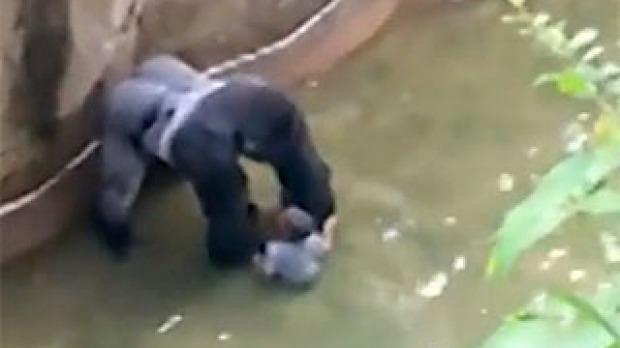More experts have weighed on the death of 17-year-old gorilla, Harambe, after it was shot when a 3-year-old child fell inside his cage last week.
Animal ethologist Marc Bekoff has questioned whether western lowland gorillas like Harambe should be in zoos to begin with. He said, according to Scientific American:
“In all, Harambe’s freedoms were taken from him the moment he was born into captivity and his protection taken from him when his space was violated by human activities. While it’s most likely that Harambe and other animals kept in cages in zoos would prefer to be free, it’s also likely that he viewed his cage as his home and felt safe in familiar environs. Let’s remember in head and heart that Harambe was killed for being forced to live in a cage for the benefit of others, not his own.”
Emory University primatologist Frans de Waal questioned what course of action could have been taken to save the gorilla, according to his Facebook post:
“I honestly don’t know what I would have decided under the circumstances—it would have depended on the precise information that would have reached me — but at the same time can’t help but wonder what would have happened had the public been moved out of the way, and also the veterinary and security staff would have been held back, so that only animal care staff familiar to Harambe would have been left around. Under such circumstances, calm might have returned and, who knows, the child might have been left unharmed.”
But Ian Redmond, chairman of the UK-based conservation charity the Gorilla Organisation, told the Guardian that he questioned the zoo’s decision to shoot the animal:
“Was a lethal shot the only option? No, I don’t think so. Were other options tried? You could have offered the gorilla more fruit than he could ever normally imagine in one sitting and then the boy would have become less interesting to him. It seemed like no one was prepared to go into the enclosure.”
He added:
What else might have been tried? I agree with the zoo director who felt a tranquilliser dart gun, which delivers a painful jab in the behind, could have startled Harambe and in the time it would take to have an effect, might have put the child at greater risk. Gorillas have a reasoning mind, however, and if someone known and trusted by Harambe had tried to calm him, perhaps offering something that would immediately attract his attention such as a tray of his favourite fruits, a negotiated settlement might have been possible (all the while with the marksman in position to shoot if necessary). Perhaps this was tried, but there has been no mention of it.
He went even further:
Aside from the wider ethical issues of keeping apes (or indeed any self-aware, nonhuman beings such as elephants and dolphins) in captivity, this tragic incident raises two key questions. How is it possible – yet again – for a child to gain such easy access to any zoo enclosure? Especially when zoos are primarily a family attraction. Even if no gorillas were involved, surely public safety standards require that a child cannot get to a 15ft drop so easily. And second, will zoo professionals amend their emergency protocols to try non-lethal methods first, with a marksman ready to shoot but only in the event that lethal force is necessary? Then such tragic events might be avoided in the future.
And a former zookeeper, Amanda O'Donoughue, said that gorillas aren’t child-killers, but she said the boy was in danger being with the ape, she wrote on Facebook:
“Gorillas are considered a Class I mammal, the most dangerous class of mammals in the animal kingdom, again, merely due to their size and strength. They are grouped in with other apes as well as tigers, lions, and bears. In a zoo accredited by the Association of Zoos and Aquariums, keepers do not work in direct contact with gorillas; they never share an enclosed space with these animals. There is always a welded mesh barrier between the animal and the humans.”
Cincinnati Zoo director Thane Maynard defended the zoo’s move, saying the exhibit was safe. The boy’s fall into the pit was a first in the zoo’s decades-long existence.
“We did not take the shooting of Harambe lightly, but that child’s life was in danger. And people who question that, or are Monday morning quarter backs, or second guessers ,don’t understand that you can’t take a chance with a silver back gorilla. They’re three times bigger than a man, six times stronger. It’s a dangerous animal…We’re talking about an animal that I’ve seen with one hand, take a coconut and crush it,” he told reporters.
Meanwhile, witnesses to the incident said the gorilla was dragging the child around.
Kim O'Connor, who recorded the viral video, said there were parts of the incident too horrific to show.
“I follow the gorilla down to the moat, I watch him drag the boy up to the top of the moat in the concrete exhibit area. After that he literally treats this small boy like a rag doll. This is not on video. I would never show it, it was that horrific,” she told WKRN.
She said the crowd was agitating Harambe. “If he saw people, he would spook. And he'd drag him more,” she explained.
“The crowd itself just kept going crazy, making him more agitated. At one point I honestly thought he was going to throw that kid back at us. But he stayed with him,” she added.





